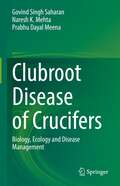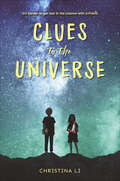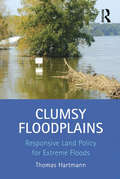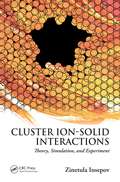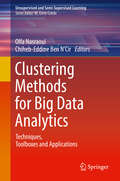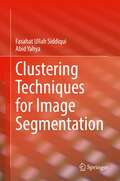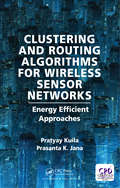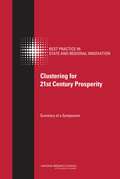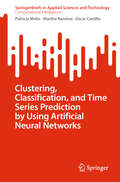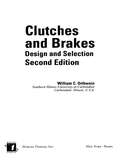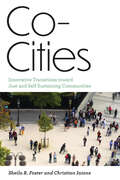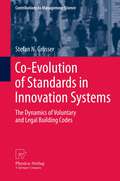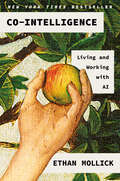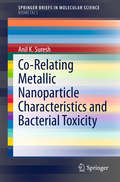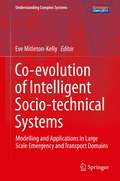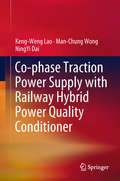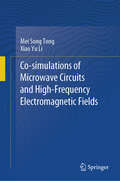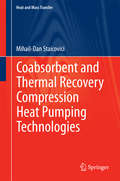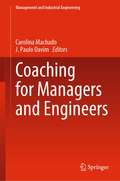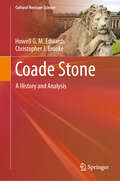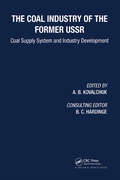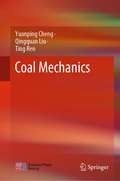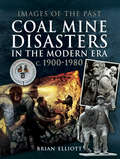- Table View
- List View
Clubroot Disease of Crucifers: Biology, Ecology and Disease Management
by Govind Singh Saharan Prabhu Dayal Meena Naresh K. MehtaThe book is presenting a comprehensive information on fundamental, and applied knowledge of Plasmodiophora brassicae Woronin. infecting cruciferous crops, and weeds. Clubroot of crucifers has spread over more than 88 countries of the world with average annual loss of cruciferous crops from 10-15 per cent at global level. It is considered as a disease of cultivation since once introduced in a field, its inoculum piles up year by year in the form of resilient resting spores of P. brassicae which spreads in the field through field operations. This disease is very unique since the pathogen can survive in the soil in the rhizosphere of non-host plants in addition to its main host cruciferous species, cultivated or wild. This book complies inclusive information about the disease, its geographical distribution, symptoms, host range, yield losses, and disease assessment scales. The book also explores host-parasite interactions in the form of seed infection, disease cycle, process of infection, pathogenesis, epidemiology and forecasting. Chapters discuss the genetic and molecular mechanisms of host-parasite relationships, management practices including cultural, chemical, biological control practices, and other integrated approaches. The book is immensely useful to researchers, teachers, extension specialists, farmers, and all others who are interested to grow healthy and profitable cruciferous crops all over the world. Also the book serves as additional reading material for undergraduate and graduate students of agriculture and especially plant pathology. National and international agricultural scientists, policy makers will also find this to be a useful read.
Clues to the Universe
by Christina LiThis stellar debut about losing and finding family, forging unlikely friendships, and searching for answers to big questions will resonate with fans of Erin Entrada Kelly and Rebecca Stead.The only thing Rosalind Ling Geraghty loves more than watching NASA launches with her dad is building rockets with him. When he dies unexpectedly, all Ro has left of him is an unfinished model rocket they had been working on together.Benjamin Burns doesn’t like science, but he can’t get enough of Spacebound, a popular comic book series. When he finds a sketch that suggests that his dad created the comics, he’s thrilled. Too bad his dad walked out years ago, and Benji has no way to contact him.Though Ro and Benji were only supposed to be science class partners, the pair become unlikely friends, and Ro even figures out a way to reunite Benji and his dad. But Benji hesitates, which infuriates Ro. Doesn’t he realize how much Ro wishes she could be in his place?As the two face bullying, grief, and their own differences, Benji and Ro try to piece together clues to some of the biggest questions in the universe.A Washington Post KidsPost Summer Book Club selection * A Junior Library Guild Selection * A Bank Street Best Book of the Year
Clumsy Floodplains: Responsive Land Policy for Extreme Floods
by Thomas HartmannExtreme floods cause enormous damage in floodplains, which levees cannot prevent. Therefore, it is vital for spatial planning to provide space for water retention in these areas. Land use planners, water management agencies, landowners, and policymakers all agree on this challenge, but attempts to make the space for rivers to provide retention are generally not very successful. Adopting an innovative interdisciplinary approach, this book examines how society can manage the use of the floodplains along rivers in the face of extreme floods, focusing in particular on the relation between social arrangements and the elemental forces of floods. The book firstly analyses why contemporary floodplain management is so often clumsy and ineffective by looking at various real-life situations in Germany, using Cultural Theory to provide a much-needed, but previously neglected social perspective. These analyses show a pattern of activity resulting from different rationalities which dominate the floodplains in different phases. During extreme floods, it is rational to manage floodplains as dangerous areas; sandbags and disaster management dominate the scene. After some time, the rationality of control takes over the floodplain management; policymakers discuss flood risk and water managers build levees. When public attention diminishes, floodplains become inconspicuous until more and more stakeholders regard floodplains as profitable land. The current system of planning, law, and property rights even encourages stakeholders to act out their plural rationalities. A permanent dynamic imbalance of different rationalities leads to a robust social construction of the floodplains which results in viable but clumsy floodplains. In the course of time, however, the patterns of activity in the floodplains lead to an increase in intensity and frequency of extreme floods, and to more vulnerable potential damages in the floodplains. Risk increases. Coping with this situation needs another kind of floodplain management. This book proposes an innovative concept - Large Areas for Temporary Emergency Retention (LATER) - in "Clumsy Floodplains" as an alternative to levee-based flood protection. The concept aims at reducing damage by extreme floods in a catchment area by inundating less valuable areas to protect places that are more valuable. It finally examines how this LATER concept might be implemented in areas where there is currently a clumsy style of floodplain management, what interventions are required and how these might come about effectively. Again, using Cultural Theory, the book puts forward a valuable land policy solution which aims at implementing LATER in clumsy floodplains and which develops an obligatory insurance against natural hazards as a responsive land policy for LATER. The book represents the author's PhD research, which he conducted as research assistant at the department for Land Policy, Land Management and Municipal Geoinformation at the School of Spatial Planning, TU Dortmund University, Germany.
Cluster Ion-Solid Interactions: Theory, Simulation, and Experiment
by Zinetula InsepovCluster Ion-Solid Interactions: Theory, Simulation, and Experiment provides an overview of various concepts in cluster physics and related topics in physics, including the fundamentals and tools underlying novel cluster ion beam technology. The material is based on the author's highly regarded courses at Kyoto University, Purdue University, the Mos
Clustering Methods for Big Data Analytics: Techniques, Toolboxes and Applications (Unsupervised and Semi-Supervised Learning)
by Olfa Nasraoui Chiheb-Eddine Ben N'CirThis book highlights the state of the art and recent advances in Big Data clustering methods and their innovative applications in contemporary AI-driven systems. The book chapters discuss Deep Learning for Clustering, Blockchain data clustering, Cybersecurity applications such as insider threat detection, scalable distributed clustering methods for massive volumes of data; clustering Big Data Streams such as streams generated by the confluence of Internet of Things, digital and mobile health, human-robot interaction, and social networks; Spark-based Big Data clustering using Particle Swarm Optimization; and Tensor-based clustering for Web graphs, sensor streams, and social networks. The chapters in the book include a balanced coverage of big data clustering theory, methods, tools, frameworks, applications, representation, visualization, and clustering validation.
Clustering Techniques for Image Segmentation
by Abid Yahya Fasahat Ullah SiddiquiThis book presents the workings of major clustering techniques along with their advantages and shortcomings. After introducing the topic, the authors illustrate their modified version that avoids those shortcomings. The book then introduces four modified clustering techniques, namely the Optimized K-Means (OKM), Enhanced Moving K-Means-1(EMKM-1), Enhanced Moving K-Means-2(EMKM-2), and Outlier Rejection Fuzzy C-Means (ORFCM). The authors show how the OKM technique can differentiate the empty and zero variance cluster, and the data assignment procedure of the K-mean clustering technique is redesigned. They then show how the EMKM-1 and EMKM-2 techniques reform the data-transferring concept of the Adaptive Moving K-Means (AMKM) to avoid the centroid trapping problem. And that the ORFCM technique uses the adaptable membership function to moderate the outlier effects on the Fuzzy C-meaning clustering technique. This book also covers the working steps and codings of quantitative analysis methods. The results highlight that the modified clustering techniques generate more homogenous regions in an image with better shape and sharp edge preservation.Showcases major clustering techniques, detailing their advantages and shortcomings;Includes several methods for evaluating the performance of segmentation techniques;Presents several applications including medical diagnosis systems, satellite imaging systems, and biometric systems.
Clustering and Routing Algorithms for Wireless Sensor Networks: Energy Efficiency Approaches
by Pratyay Kuila Prasanta K JanaWireless Sensor Networks have a wide range of applications in different areas. Their main constraint is the limited and irreplaceable power source of the sensor nodes. In many applications, energy conservation of the sensor nodes and their replacement or replenishment due to the hostile nature of the environment is the most challenging issue. Energy efficient clustering and routing are the two main important topics studied extensively for this purpose. This book focuses on the energy efficient clustering and routing with a great emphasis on the evolutionary approaches. It provides a comprehensive and systematic introduction of the fundamentals of WSNs, major issues and effective solutions.
Clustering for 21st Century Prosperity: Summary of a Symposium
by Charles W. WessnerResponding to the challenges of fostering regional growth and employment in an increasingly competitive global economy, many U. S. states and regions have developed programs to attract and grow companies as well as attract the talent and resources necessary to develop regional innovation clusters. These state and regionally based initiatives have a broad range of goals and increasingly include larger resources commitments, often with a sectoral focus and often in partnership with foundations and universities. Recent studies, however, have pointed out that many of these efforts lack the scale and the steady commitment needed for success. This has prompted new initiatives to coordinate and concentrate investments from a variety of federal agencies to develop research parks, business incubators, and other strategies to encourage entrepreneurships and high-tech development in the nation's regions. Understanding the nature of innovation clusters and public policies associated with successful cluster development is therefore of current relevance. Clustering for 21st Century Prosperity identifies best practices with regard to goals, structures, instruments, modes of operation, synergies across private and public programs, funding mechanisms and levels, and evaluation efforts. The committee, under the Board on Science, Technology, and Economic Policy (STEP) is reviewing selected state and regional efforts to capitalize on federal and state investments in areas of critical national needs. This review includes both efforts to strengthen existing industries as well as specific technology focus areas such as nanotechnology, stem cells, and advanced energy in order to better understand program goals, challenges, and accomplishments. As part of this study, the committee is convening a series of public workshops and symposia involving responsible local, state, and federal officials and other stakeholders. Drawing from discussions at these symposia, fact-finding meetings, and commissioned analyses of existing state and regional programs and technology focus areas, the committee will subsequently produce a final report with findings and recommendations focused on lessons, issues, and opportunities for complementary U. S. policies created by these state and regional initiatives.
Clustering, Classification, and Time Series Prediction by Using Artificial Neural Networks (SpringerBriefs in Applied Sciences and Technology)
by Oscar Castillo Patricia Melin Martha RamirezThis book provides a new model for clustering, classification, and time series prediction by using artificial neural networks to computationally simulate the behavior of the cognitive functions of the brain is presented. This model focuses on the study of intelligent hybrid neural systems and their use in time series analysis and decision support systems. Therefore, through the development of eight case studies, multiple time series related to the following problems are analyzed: traffic accidents, air quality and multiple global indicators (energy consumption, birth rate, mortality rate, population growth, inflation, unemployment, sustainable development, and quality of life). The main contribution consists of a Generalized Type-2 fuzzy integration of multiple indicators (time series) using both supervised and unsupervised neural networks and a set of Type-1, Interval Type-2, and Generalized Type-2 fuzzy systems. The obtained results show the advantages of the proposed model of Generalized Type-2 fuzzy integration of multiple time series attributes. This book is intended to be a reference for scientists and engineers interested in applying type-2 fuzzy logic techniques for solving problems in classification and prediction. We consider that this book can also be used to get novel ideas for new lines of research, or to continue the lines of research proposed by the authors of the book.
Clutches and Brakes: Design and Selection
by William C. OrthweinConveniently gathering formulas, analytical methods, and graphs for the design and selection of a wide variety of brakes and clutches in the automotive, aircraft, farming, and manufacturing industries, Clutches and Brakes: Design and Selection, Second Edition simplifies calculations, acquaints engineers with an expansive range of application, and a
Co-Cities: Innovative Transitions toward Just and Self-Sustaining Communities (Urban and Industrial Environments)
by Sheila R. Foster Christian IaioneA new model of urban governance, mapping the route to a more equitable management of a city&’s infrastructure and services.The majority of the world&’s inhabitants live in cities, but even with the vast wealth and resources these cities generate, their most vulnerable populations live without adequate or affordable housing, safe water, healthy food, and other essentials. And yet, cities also often harbor the solutions to the inequalities they create, as this book makes clear. With examples drawn from cities worldwide, Co-Cities outlines practices, laws, and policies that are presently fostering innovation in the provision of urban services, spurring collaborative economies as a driver of local sustainable development, and promoting inclusive and equitable regeneration of blighted urban areas. Identifying core elements of these diverse efforts, Sheila R. Foster and Christian Iaione develop a framework for understanding how certain initiatives position local communities as key actors in the production, delivery, and management of urban assets or local resources. Within this framework, they explain the forms such initiatives increasingly take, like community land trusts, new kinds of co-housing, neighborhood cooperatives, community-shared broadband and energy networks, and new local offices focused on citizen science and civic imagination. The &“Co-City&” framework is uniquely rooted in the authors&’ own decades-long research and first-hand experience working in cities around the world. Foster and Iaione offer their observations as &“design principles&”—adaptable to local context—to help guide further experimentation in building just and self-sustaining urban communities.
Co-Evolution of Standards in Innovation Systems: The Dynamics of Voluntary and Legal Building Codes (Contributions to Management Science)
by Stefan N. GrösserMitigating climate change is one of the most profound challenges facing humankind. In industrialized countries, the residential housing sector produces roughly one-fourth of the greenhouse gas emissions. One solution to reduce these emissions is the availability of building codes that require high levels of energy efficiency. Given the current scientific knowledge, more research is needed to gain a proper systemic understanding of the underlying socio-economic and technical system. Such an understanding is crucial for developing high energy-efficiency standards because this system develops gradually over time and cannot be changed swiftly. This book creates a feedback-rich simulation model for analyzing the effects of different administrative policies on energy demand, the improvement of energy efficiency by means of building codes, and reductions in the greenhouse gas emissions. The dynamic model can contribute substantially to the discourse on energy policies and guide effective administrative interventions. The book will be a valuable resource for officials in the public energy administration, as well as researchers in the areas of innovation, diffusion processes, co-evolution, standardization, and simulation modelling.
Co-Intelligence: Living and Working With AI
by Ethan MollickFrom Wharton professor and author of the popular One Useful Thing Substack newsletter Ethan Mollick comes the definitive playbook for working, learning, and living in the new age of AI <p><p> Something new entered our world in November 2022 — the first general purpose AI that could pass for a human and do the kinds of creative, innovative work that only humans could do previously. Wharton professor Ethan Mollick immediately understood what ChatGPT meant: after millions of years on our own, humans had developed a kind of co-intelligence that could augment, or even replace, human thinking. Through his writing, speaking, and teaching, Mollick has become one of the most prominent and provocative explainers of AI, focusing on the practical aspects of how these new tools for thought can transform our world. <p><p> In Co-Intelligence, Mollick urges us to engage with AI as co-worker, co-teacher, and coach. He assesses its profound impact on business and education, using dozens of real-time examples of AI in action. Co-Intelligence shows what it means to think and work together with smart machines, and why it’s imperative that we master that skill. <p><p> Mollick challenges us to utilize AI’s enormous power without losing our identity, to learn from it without being misled, and to harness its gifts to create a better human future. Wide ranging, hugely thought-provoking, optimistic, and lucid, Co-Intelligence reveals the promise and power of this new era. <p> <b>New York Times Bestseller</b>
Co-Relating Metallic Nanoparticle Characteristics and Bacterial Toxicity (SpringerBriefs in Molecular Science)
by Anil K. SureshThis brief gives a concise overview of nanoparticles and their microbial toxicity. It introduces various nanoparticles that are considered lethal to microbial cells (bacteria, virus and fungus) placing an emphasis on metal and metal oxide nanoparticles. The synthesis procedures (physical, chemical, microbial) that are often employed in their fabrication are also outlined. The interaction of various nanoparticles with microbes is described with attention given to the role of additives in the form of solvents, surfactants, capping materials. Commonly used experimental and analytical techniques that are often used to evaluate and determine the toxicity of nanoparticles towards different microorganisms are presented and comparative assessments on the differences between these procedures are described. The brief ends by explaining the toxicity of metal and metal oxide nanoparticles to microorganisms.
Co-benefits of Sustainable Forestry: Ecological Studies of a Certified Bornean Rain Forest (Ecological Research Monographs)
by Kanehiro KitayamaTropical rain forests are increasingly expected to serve for climate change mitigation and biodiversity conservation amid global climate change and increasing human demands for land. Natural production forests that are legally designated to produce timber occur widely in the Southeast Asian tropics. Synergizing timber production, climate change mitigation and biodiversity conservation in such tropical production forests is one of the most realistic means to resolve these contemporary global problems. Next-generation sustainable forest management is being practiced in the natural tropical rain forest of a model site in Sabah, Malaysian Borneo, while earlier sustainable management practices have generally failed, leading to extensive deforestation and forest degradation elsewhere in the tropics. Ecologists have examined co-benefits of sustainable forestry in the model forest in terms of forest regeneration, carbon sequestration and biodiversity in comparison to a forest managed by destructive conventional methods. Taxonomic groups studied have included trees, decomposers, soil microbes, insects and mammals. A wide array of field methods and technology has been used including count plots, sensor cameras, and satellite remote-sensing. This book is a compilation of the results of those thorough ecological investigations and elucidates ecological processes of tropical rain forests after logging. The book furnishes useful information for foresters and conservation NGOs, and it also provides baseline information for biologists and ecologists. A further aim is to examine the environmental effects of a forest certification scheme as the model forest has been certified by the Forest Stewardship Council. Taken as a whole, this book proves that the desired synergy is possible.
Co-evolution of Intelligent Socio-technical Systems: Modelling and Applications in Large Scale Emergency and Transport Domains (Understanding Complex Systems)
by Evangelia Mitleton-KellyAs the interconnectivity between humans through technical devices is becoming ubiquitous, the next step is already in the making: ambient intelligence, i.e. smart (technical) environments, which will eventually play the same active role in communication as the human players, leading to a co-evolution in all domains where real-time communication is essential. This topical volume, based on the findings of the Socionical European research project, gives equal attention to two highly relevant domains of applications: transport, specifically traffic, dynamics from the viewpoint of a socio-technical interaction and evacuation scenarios for large-scale emergency situations. Care was taken to investigate as much as possible the limits of scalability and to combine the modeling using complex systems science approaches with relevant data analysis.
Co-phase Traction Power Supply with Railway Hybrid Power Quality Conditioner
by Man-Chung Wong Keng-Weng Lao NingYi DaiThis book offers a brief review of and investigations into the power quality problem in the new technology of co-phase high-speed traction power supplies, which benefits for higher locomotive speed. In addition, it presents detailed design procedures and discusses the chief concerns in connection with a newly proposed solution: compensation in co-phase traction power using a co-phase railway hybrid power quality conditioner (Railway HPQC). Further, it provides essential information on the modeling of power quality in co-phase, high-speed traction power supplies, and on power quality compensation algorithm derivations. Lastly, it delineates the design of railway HPQC and analyzes the effect of different parameters on its performance to accommodate different priorities. All design is supported by simulations and the results of experimental verification.
Co-simulations of Microwave Circuits and High-Frequency Electromagnetic Fields
by Mei Song Tong Xiao Yu LiThis book aims to provide many advanced application topics for microwave circuits and high-frequency electromagnetic (EM) fields by using advanced design system (ADS) and high-frequency structure simulator (HFSS) as simulation platforms. In particular, it contains the latest multidisciplinary co-simulation guidance on the design of relevant components and devices. Currently, the circuit/field design and performance analysis and optimization strongly rely on various kinds of robust electronic design automation (EDA) software. RF/microwave engineers must grasp two or more types of related simulation design software. ADS by Keysight and HFSS by Ansys are the representative for circuit simulations and for field and structural simulations of microwave devices, respectively. At present, these two types of software are widely used in enterprises, universities, and research institutions. The main purpose of this book is to enable readers, who are interested in microwave engineering and applied electromagnetics, to master the applications of these two tools. It also helps readers expand their knowledge boundaries behind those types of software and deepen their understanding of developing interdisciplinary technologies by co-simulations. The book is divided into three parts. The first part introduces the two latest versions of ADS and HFSS and helps readers better understand the basic principles and latest functions better. It also advises how to choose appropriate simulation tools for different problems. The second part mainly describes co-simulations for high-frequency EM fields, microwave circuits, antenna designs, EM compatibility (EMC), and thermal and structural analyses. It provides guides and advices on performing co-simulations by ADS and HFSS incorporated with other types of software, respectively. The last part narrates the automation interfaces and script programming methods for co-simulations. It primarily deals with the Advanced Extension Language (AEL), Python Data Link (PDL), and MATLAB interface in ADS. For HFSS, it discusses VBScript, IronPython scripting, and Application Programming Interface (APIs) based on MATLAB. Each topic contains practical examples to help readers understand so that they can gain a solid knowledge and skills regarding automated interfaces and scripting methods based on these kinds of software. Concisely written in combination with practical examples, this book is very suitable as a textbook in introductory courses on microwave circuit and EM simulations and also as a supplementary textbook in many courses on electronics, microwave engineering, communication engineering, and related fields. As well, it can serve as a reference book for microwave engineers and researchers.
Coabsorbent and Thermal Recovery Compression Heat Pumping Technologies (Heat and Mass Transfer)
by Mihail-Dan StaicoviciThis book introduces two of the most exciting heat pumping technologies, the coabsorbent and the thermal recovery (mechanical vapor) compression, characterized by a high potential in primary energy savings and environmental protection. New cycles with potential applications of nontruncated, truncated, hybrid truncated, and multi-effect coabsorbent types are introduced in this work Thermal-to-work recovery compression (TWRC) is the first of two particular methods explored here, including how superheat is converted into work, which diminishes the compressor work input. In the second method, thermal-to-thermal recovery compression (TTRC), the superheat is converted into useful cooling and/or heating, and added to the cycle output effect via the coabsorbent technology. These and other methods of discharge gas superheat recovery are analyzed for single-, two-, three-, and multi-stage compression cooling and heating, ammonia and ammonia-water cycles, and the effectiveness results are given. The author presents absorption-related topics, including the divided-device method for mass and heat transfer analysis, and truncation as a unique method for a better source-task match. Along with advanced gax recovery, the first and second principles of COP and exergy calculation, the ideal point approaching (i. p. a. ) effect and the two-point theory of mass and heat transfer, the book also addresses the new wording of the Laplace equation, the Marangoni effect true explanation, and the new mass and heat exchangers based on this effect The work goes on to explore coabsorbent separate and combined cooling, heating, and power (CHP) production and advanced water-lithium bromide cycle air-conditioning, as well as analyzing high-efficiency ammonia-water heat-driven heating and industrial low-temperature cooling, in detail Readers will learn how coabsorbent technology is based on classic absorption, but is more general. It is capable of offering effective solutions for all cooling and heating applications (industry, agriculture, district, household, etc. ), provided that two supplying heat-sink sources with temperatures outdistanced by a minimum of 12-15ºC are available This book has clear and concise presentation and illustrates the theory and applications with diagrams, tables, and flowcharts.
Coach in Progress: Marshall Football?A Story of Survival and Revival
by Bobby Bowden Patrick Garbin Red Dawson Fred BiletnikoffA Coach in Progress depicts the catastrophe of the Southern Airways flight that crashed en route to Huntington, West Virginia, in 1970, killing all seventy-five passengers on board: players, coaches, and boosters of the Marshall University football team, as well as the flight crew. From this tragedy, the foundation of the Marshall football program was laid, and it has thrived ever since, culminating with the Thundering Herd being the winningest team in the NCAA Division I program in the 1990s, portrayed in the hit movie We Are Marshall, and currently under the direction of head coach Doc Holliday. This book is written from the viewpoint of Red Dawson, a former Marshall assistant football coach, who was one of the few team members not on the plane. Still suffering from survivor’s guilt decades after the crash, Red has recovered enough to finally discuss the disaster in full. What’s more, Red helped build a team with mostly freshmen and walk-ons in 1971, and thus was recognized as bridging "the gap from tragedy to rebirth” of the Marshall football program. Red also reveals what he previously would not discuss: the seemingly insurmountable obstacles he faced prior to the plane crash and the difficulties that followed the tragedy, like the heated tension that persisted between school administrators and a harassed and confused Red as they all attempted to rebuild the devastated program. This book is the story of Red Dawson’s involvement with Marshall football during the last near half century spent living with the memories of the worst sports-related air tragedy in history.
Coaching for Managers and Engineers (Management and Industrial Engineering)
by J. Paulo Davim Carolina MachadoThis book communicates the latest developments and thinking on the coaching subject worldwide. It presents insights into coaching in the management and engineering field on an international and transnational scale. The chapters contain innovative models, processes, strategies and uses, as well as the most recent research activities relating to coaching. This book highlights key issues and uses related to coaching for managers and engineers.
Coade Stone: A History and Analysis (Cultural Heritage Science)
by Howell G. Edwards Christopher J. BrookeThe history and nature of artificial stone for use in architecture is a subject still shrouded in myth and misconception. This book aims to lay bare those misconceptions and present a scientific and architectural account of these materials, and especially Coade Stone, the most successful of all, which found great favour during the Georgian period. Many examples of Coade Stone cast sculpture still exist and several key examples are presented in context and as case studies . Eleanor Coade’s artificial stone was so good that many observers could not distinguish it from the natural stone it replaced: the growth in replication of the neo-classical statuary and building adornment required in the late Georgian and Regency period was well satisfied by the use of Coade stone. A holistic evaluation of Coade stone artefacts is undertaken whereby the use of analytical data, historical documentation, invoices, company records, impressed marks and expert connoisseurship will establishthe attribution of Coade stone artefacts, some of which are currently in the unknown category. Several new scientific analyses are presented that demonstrate the true nature of high temperature fired ceramic Coade Stone and allow comparison with other forms of artificial stone, such as the cold cured cementitious variations, which eventually replaced it in the Victorian period.
Coal Industry of the Former USSR: Coal Supply System and Industry Development
by A. B. Kovalchuk B. C. HardingeThe Coal Industry of the Former USSR presents a two-part study of coal supply systems and development of the industry in the territory of the former USSR. The first part covers the role of coal in the economy, provides an overview of current status and forecast of the eight major coal basins and environmental problems associated with the industry.
Coal Mechanics
by Yuanping Cheng Qingquan Liu Ting RenThis book focuses on the mechanical properties and permeability of coal, and the gas flow in coal seams. Based on coal permeability models, it establishes different models for coal seam gas, from the linear flow model to the gas–solid coupling flow model. It also provides the theoretical basis for the exploitation and safe production of coal as well as coal seam gas resources. As such, it is a valuable reference for researchers, advanced students and practitioners working in mining engineering and coalbed methane engineering.
Coal Mine Disasters in the Modern Era c. 1900–1980 (Images of the Past)
by Brian Elliott&“These haunting images, with well-researched facts, figures and timelines providing context, bring the bygone era of 20th-century coal mining to life.&”—Family Tree Although everyday fatalities in mines was far greater, it was the disasters that encouraged those in power to reform the way in which miners had to work underground, especially with regard to safety. And it would be no exaggeration to say that it was the disasters that greatly contributed to bringing the coal industry into national control. Sadly, for bereaved individuals and families, nothing could really compensate for the loss of one or more of a loved one. The impact of the big disasters, where hundreds of men and boys—one or two generations—were lost, immediately, the impact was massive, and continued to be felt many years afterwards. New and restored disaster memorials bear testimony to the great respect that former mining communities continue to have for their &“lost miners.&” Using many previously unpublished images, and a carefully supportive text, the author provides a detailed overview of mining disasters in the modern era, from the early 1900s to the 1980s. It is the first book of its kind to attempt such a large project in pictorial form with a foreword by Ceri Thompson, curator of the Big Pit, the Welsh national mining museum. The book is published at a particularly poignant time, after the recent closure of Britain&’s last deep coal mine. &“So many remarkable photographs and drawings: The story may be tragic, but it is one that lies at the very heart of the history of coal mining in Britain.&”—WDYTYA? magazine
